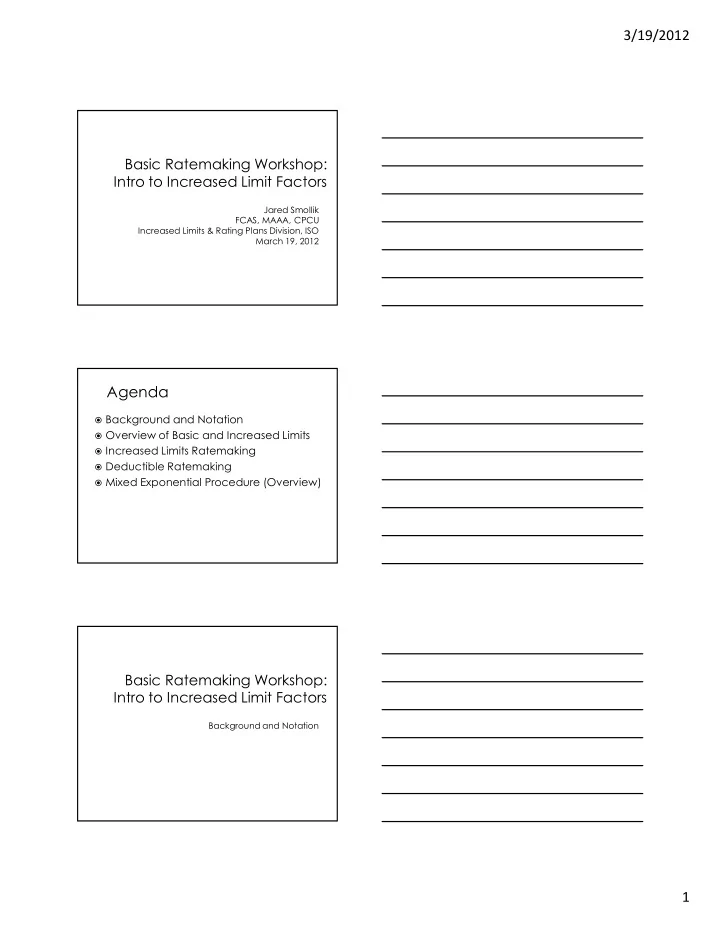

3/19/2012 Basic�Ratemaking�Workshop: Intro�to�Increased�Limit�Factors Jared�Smollik FCAS,�MAAA,�CPCU Increased�Limits�&�Rating�Plans�Division,�ISO March�19,�2012 Agenda � Background�and�Notation � Overview�of�Basic�and�Increased�Limits � Increased�Limits�Ratemaking � Deductible�Ratemaking � Mixed�Exponential�Procedure�(Overview) Basic�Ratemaking�Workshop: Intro�to�Increased�Limit�Factors Background�and�Notation 1
3/19/2012 Loss�Severity�Distributions Probability�Density�Function�(PDF)�– f � x � � describes�the�probability�density�of�the� outcome�of�a�random�variable� X � theoretical�equivalent�of�a�histogram�of� empirical�data Loss�severity�distributions�are�skewed � a�few�large�losses�make�up�a�significant� portion�of�the�total�loss�dollars Loss�Severity�Distributions f � x � example�loss� severity�PDF ∞ loss�size � Loss�Severity�Distributions Cumulative�Distribution�Function�(CDF) � describes�the�probability�that�a�random� variable� X takes�on�values�less�than�or� equal�to� x x ] ∫ [ = ≤ = F � x � �� X x f � t � dt � 2
3/19/2012 Loss�Severity�Distributions example�loss� � severity�CDF F � x � � ∞ loss�size Mathematical�Notation Expected�Value�(mean,� � ,�first�raw� moment) � average�value�of�a�random�variable ∞ [ ] ∫ = E X xf � x � dx � ∞ ∫ = = − S � x � dx � ������ � S � x � � F � x � � Mathematical�Notation Limited�Expected�Value�(at�k) � expected�value�of�the�random�vairable limited�to�a�maximum�value�of�k � often�referred�to�as�the�limited�average� severity�(LAS)�when�working�with�losses ≤ X � ������ � X k ∧ = X k > k � ������ � X k k k ) ∫ [ ] ( ∫ ∧ = + − = E X k xf � x � dx k � F � k � S � x � dx � � 3
3/19/2012 Basic�Ratemaking�Workshop: Intro�to�Increased�Limit�Factors Overview�of�Basic�and�Increased�Limits Basic�and�Increased�Limits Different�insureds have�different�coverage� needs,�so�third7party�liability�coverage�is� offered�at�different�limits. Typically,�the�lowest�level�of�insurance� offered�is�referred�to�as�the�basic�limit� and�higher�limits�are�referred�to�as� increased�limits. Basic�and�Increased�Limits Basic�Limit�loss�costs�are�reviewed�and�filed�on�a� regular�basis�(perhaps�annually) � a�larger�volume�of�losses�capped�at�the�basic� limit�can�be�used�for�a�detailed�experience� analysis � experience�is�more�stable�since�large,�volatile� losses�are�capped�and�excluded�from�the� analysis Higher�limits�are�reviewed�less�frequently � requires�more�data�volume � fewer�policies�are�written�at�higher�limits � large�losses�are�highly�variable 4
3/19/2012 Basic�Ratemaking�Workshop: Intro�to�Increased�Limit�Factors Increased�Limits�Ratemaking Increased�Limits�Ratemaking Basic�Limit�data�aggregation � losses�are�restated�as�if�all�policies�were� purchased�at�the�basic�limit � basic�limit�is�usually�the�financial� responsibility�limit�or�a�commonly�selected� limit � ALAE�is�generally�uncapped Increased�Limits�data�aggregation � losses�are�limited�to�a�higher�limit � ALAE�generally�remains�uncapped Increased�Limits�Ratemaking � the�process�of�developing�charges�for� expected�losses�at�higher�limits�of�liability � usually�results�in�a�multiplicative�factor�to� be�applied�to�the�basic�limit�loss�cost,�i.e.� the�increased�limit�factor�(ILF) �������� � ���� � ������� � ��� ������� ������ k = ��� � k � �������� � ���� � ������� � ��� ����� � ������ b 5
3/19/2012 Increased�Limits�Ratemaking A�key�assumption�of�IL�ratemaking�is�that� claim�frequency�is�independent�of�claim� severity � claim�frequency�does�not�depend�on� policy�limit � only�claim�severity�is�needed�to� calculate�ILFs Increased�Limits�Ratemaking �������� � ���� � ������� � ��� ������� ������ k = ��� � k � �������� � ���� � ������� � ��� ����� � ������ b [ ] [ ] × E ������ �� E �������� = k k [ ] [ ] × E ������ �� E �������� b b [ ] [ ] × E ������ �� E �������� = k [ ] [ ] × E ������ �� E �������� b [ ] [ ] ∧ E �������� E X k = = k [ ] [ ] ∧ E �������� E X b b Increased�Limits�Ratemaking For�practical�purposes,�the�expected�costs� include�a�few�components: � limited�average�severity � allocated�loss�adjustment�expenses � unallocated�loss�adjustment�expenses � risk�load We�will�focus�mostly�on�LAS,�with�some� discussion�of�ALAE. 6
3/19/2012 Calculating�an�ILF using� Empirical�Data The�basic�limit�is�$100k.�Calculate� ILF($1000k)�given�the�following�set�of� ground7up,�uncapped�losses. Recall�ILF( k )=E[ X ^ k ]/E[ X ^ b ]. Losses� � $50,000 $75,000 $150,000 $250,000 $1,250,000 Calculating�an�ILF using� Empirical�Data Losses� � min{ � ,�$100k} min{ � ,�$1000k} $50,000 $50,000 $50,000 $75,000 $75,000 $75,000 $150,000 $100,000 $150,000 $250,000 $100,000 $250,000 $1,250,000 $100,000 $1,000,000 ILF( k )=E[ X ^ k ]/E[ X ^ b ] E[X^$100k]�=�$425,000/5�=�$85,000 E[X^$1000k] =�$1,525,000/5�=�$305,000 ILF($1000k) =�E[X^$1000k]/E[X^$100k]�=�3.59 Calculating�an�ILF using� Empirical�Data The�basic�limit�is�$25k.�Calculate�ILF($125k)� given�the�following�set�of�losses. Losses� � $5,000 $17,500 $50,000 $162,500 $1,250,000 7
3/19/2012 Calculating�an�ILF using� Empirical�Data Losses� � $5,000 $17,500 $50,000 $162,500 $1,250,000 Aggregating�and�Limiting�Losses Size�of�Loss�method � individual�losses�are�grouped�by�size�into� predetermined�intervals � the�aggregate�loss�within�each�interval�is� limited,�if�necessary,�to�the�limit�being� reviewed � ALAE�is�added�to�the�aggregate�limited� loss Aggregating�and�Limiting�Losses ∗ = − S � x � � F � x � Loss� Size k ∫ = + × E # X " k ! xdF � x � k S � k � � k x 0 1 F � x � 8
3/19/2012 Aggregating�and�Limiting�Losses Layer�method � individual�losses�are�sliced�into�layers� based�on�predetermined�intervals � for�each�loss,�the�amount�of�loss� corresponding�to�each�layer�is�added�to� the�aggregate�for�that�layer � the�aggregate�loss�for�each�layer�up�to� the�limit�is�added�together � ALAE�is�added�to�the�aggregate�limited� loss Layer�Method ∗ = − S � x � � F � x � Loss� Size k ∫ = E # X " k ! S � x � dx � k x 0 1 F � x � Size�Method�vs Layer�Method Size�Method Layer�Method � conceptually straightforward � computationally�simple�for� Advantages � data�can�be�used�in� calculating sets�of�increased�limit� calculations�immediately factors � more�complicated�integral�is� � no�integration�disadvantage� actually�generally�easier�to� when�data�is�given�numerically,� calculate which�is�generally�the�practical� case � computationally intensive�for� � unintuitive Disadvantages calculating�sets�of�increased�limit� � data�must�be�processed�so�that� factors it�can�be�used�in�calculations � S ( x ) is�generally�a�more�difficult� function�to�integrate 9
Recommend
More recommend